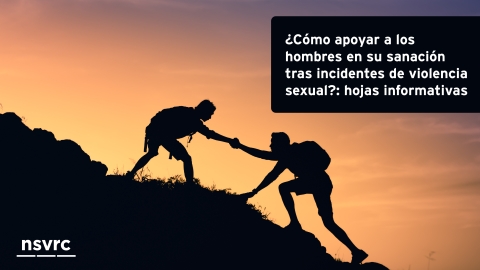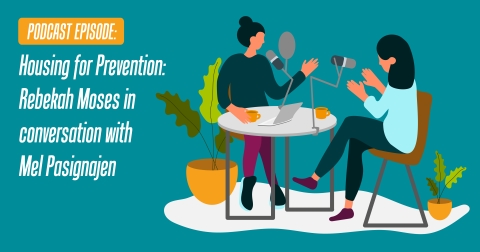- January 18, 2024
- JL Heinze
Una serie de hojas informativas sobre cómo trabajar con los hombres. Entre los temas están: cómo llegar a los hombres, adicción, sobrevivientes transmasculinos, exámenes forenses, hombres recluidos, recursos para hombres y enlaces de referencia rápida para los intercesores. Este recurso es parte del conjunto de publicaciones ¿Cómo trabajar con sobrevivientes masculinos de violencia sexual?.
- November 14, 2023
- JL Heinze
In this episode of our Housing for Prevention series, Rebekah Moses with GBV Consulting talks with Mel Pasignajen about prevention lessons learned from working in the domestic violence, sexual violence, and HIV fields. This episode is part of a series on housing for prevention that we co-created with the National Resource Center on Domestic Violence. Show Notes Meeting Sexual Violence Survivor Needs in Transitional Housing: https://resourcesharingproject.org/resources/meeting-sexual-violence-survivor-needs-in-transitional-housing/ National Resource Center on Domestic Violence: https://nrcdv.
- October 25, 2023
- JL Heinze
Just as people must be able to communicate in the language most comfortable for them, it’s vital that people are able to choose the words and terms used to define them. Language access includes accessibility to gender identity terms, consent language, and even legal vocabulary that pertain to survivor’s rights and options. For example, without the sufficient language, children suffering from sexual abuse may not know how to make sense of what’s happening, how to identify, express or talk about it. Similar can be said for adults- who may have never been supported in processing traumatic
- October 25, 2023
- JL Heinze
When we speak on language access, many people automatically assume there must be a non-English language involved. This is incorrect. For English speakers, the literacy rate for adults across the U.S. averages 88%. This means there is a larger population of people who are unable to access the key takeaways from vital content like safety instructions, resource lists, and shelter applications. As our partners at PCAR state, “People with low reading and writing skills often have less control over their own lives, less understanding of their legal rights, low self-esteem… and ultimately a
- October 25, 2023
- JL Heinze
There are more than 350 languages spoken in the United States other than English, spoken by one in five Americans. 75% of all English speakers in the world are non-native speakers. And yet, despite how common non-English and English as a Second Language (ESL) speakers are and the foundation of the United States as an immigrant nation, significant discrimination exists and pervades. As Wesley Cheung writes, “Accent discrimination is a universal yet socially accepted form of prejudice.” Non-English speakers are more likely to identify as people of color. As such, in addition to
- October 25, 2023
- JL Heinze
Language is not just words- it’s also culture. Concerns of access don’t encompass linguistic understanding only, but must also include awareness of the social norms within a community that may create unique issues or barriers. When we assume that all groups of people experience and heal from harm in the same way, it not only excludes specific demographics of people but also affirms racist ideas that white, western, mainstream culture are universal. Each community has its own history and cultural realities which contribute to risk factors, barriers to seeking help, and intervention efficacy.
- October 25, 2023
- JL Heinze
Non-Verbal, Deaf and DeafBlind Survivors Throughout our history, the most vulnerable among us have been left out of important violence prevention conversations due to real or perceived barriers to language access. People with disabilities have been among the most highly impacted by inadequate language access, including but not limited to non-verbal survivors, deafblind, and hearing impaired communities. Every language access plan should include resources and protocols for working with non-verbal, deaf, hard of hearing or deafblind communities. Non-verbal survivors experience
- October 25, 2023
- JL Heinze
According to the U.S. Census, over 22 million people living in the United States speak a language other than English at home. This means that if non-English speakers all lived in one state, they would be the third most populated state in the country. That’s more people than Wyoming, Vermont, Alaska, North Dakota, South Dakota, Delaware, Montana, Rhode Island, Maine, New Hampshire, Hawaii, West Virginia, Idaho, Nebraska, New Mexico and Kansas put together. When we visualize this data outside of just statistical numbers, it’s easier to grasp why language access is so vital to equity building
- October 24, 2023
- JL Heinze
Highlighted Resource The following resources are a must have for rape crisis centers and advocates to have available in their center to make it easier to understand what a person’s first language is. They can be shown to a survivor who can then point to their language. The use of these tools can minimize the discomfort a survivor may feel when trying to communicate and can take the pressure off them to tell you what language they speak in a way you can understand. Examples like these help streamline the process for identifying the correct interpreter. Language identifier
- August 15, 2023
- JL Heinze
In this webinar, we share our new organizational name and refreshed brand. Respect Together, our new name, was identified and embraced following an extensive rebranding process that engaged the voices and insights of many of our state and national partners. The name, paired with our new tagline “United to end sexual abuse, assault, and harassment”, reflects our commitment to work together with a wide array of partners and allies – in Pennsylvania and across the United States – to disrupt the driving forces behind sexual violence to create and uphold safe, equitable communities
Pagination
- Page 1
- Next page


